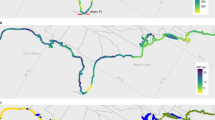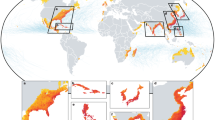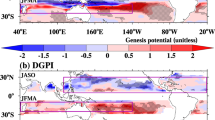Abstract
Tropical cyclone (TC) impacts are expected to worsen under continued global warming and socio-economic development. Here we combine TC simulations with an impact model to quantify country-level population exposure to TC winds for different magnitudes of global mean surface temperature increase and future population distributions. We estimate an annual global TC exposure increase of 26% (33 million people) for a 1 °C increase in global mean surface temperature, assuming present-day population. The timing of warming matters when additionally accounting for population change, with global population projected to peak around mid-century and decline thereafter. A middle-of-the-road socio-economic scenario combined with 2 °C of warming around 2050 increases exposure by 41% (52 million). A stronger mitigation scenario reaching 2 °C around 2100 limits this increase to 20% (25 million). Rapid climate action therefore avoids interference with peak global population timing and limits climate-change-driven exposure. Cumulatively, over 1.8 billion people could be saved by 2100.
This is a preview of subscription content, access via your institution
Access options
Access Nature and 54 other Nature Portfolio journals
Get Nature+, our best-value online-access subscription
$29.99 / 30 days
cancel any time
Subscribe to this journal
Receive 12 print issues and online access
$209.00 per year
only $17.42 per issue
Buy this article
- Purchase on Springer Link
- Instant access to full article PDF
Prices may be subject to local taxes which are calculated during checkout



Similar content being viewed by others
Data availability
The historical48 and future49 population data are freely available online. The historical TC exposure data are available from the Tropical Cyclone Exposure Database archive50. The TC track simulations are available for scientific purposes only and upon request from WindRiskTech (info@windrisktech.com). Requests regarding the CLIMADA impact model should be addressed to D.N.B. (dbresch@ethz.ch). The data to display country outlines and coastlines are based on the Generic Mapping Tools51. All remaining data that support the findings of this study are available from the corresponding author upon request.
Code availability
The simulations to quantify the TC impact were conducted using the Python tool CLIMADA, available at https://github.com/CLIMADA-project/climada_python/releases/tag/v2.2.0. In particular, the tool to generate the artificial TC exposure time series is freely available at https://github.com/CLIMADA-project/climada_petals/blob/main/doc/tutorial/climada_hazard_emulator.ipynb. The model to generate the TC tracks, the model to construct the temperature scenarios (MAGICC 6.8 and the climate module of the Potsdam Real-Time Integrated Model for the probabilistic assessment of emission paths (PRIMAP)) and the PRIMAP emissions module used for the creation and extension of the NDC pathways are proprietary and cannot be shared publicly. All remaining code that was used to analyse the data and produce the figures is available from the corresponding author upon request.
References
Geiger, T., Frieler, K. & Bresch, D. N. A global historical data set of tropical cyclone exposure (TCE-DAT). Earth Syst. Sci. Data 10, 185–194 (2018).
Berlemann, M. & Wenzel, D. Hurricanes, economic growth and transmission channels: empirical evidence for countries on differing levels of development. World Dev. 105, 231–247 (2018).
Peduzzi, P. et al. Global trends in tropical cyclone risk. Nat. Clim. Change 2, 289–294 (2012).
Estrada, F., Botzen, W. J. W. & Tol, R. S. J. Economic losses from US hurricanes consistent with an influence from climate change. Nat. Geosci. 8, 880–884 (2015).
Bakkensen, L. A. & Mendelsohn, R. O. Risk and adaptation: evidence from global hurricane damages and fatalities. J. Assoc. Environ. Resour. Econ. 3, 555–587 (2016).
Geiger, T., Frieler, K. & Levermann, A. High-income does not protect against hurricane losses. Environ. Res. Lett. https://doi.org/10.1088/1748-9326/11/8/084012 (2016).
Vecchi, G. A. et al. Tropical cyclone sensitivities to CO2 doubling: roles of atmospheric resolution, synoptic variability and background climate changes. Clim. Dyn. 53, 5999–6033 (2019).
Noy, I. The socio-economics of cyclones. Nat. Clim. Change 6, 343–345 (2016).
Kummu, M. et al. Over the hills and further away from coast: global geospatial patterns of human and environment over the 20th–21st centuries. Environ. Res. Lett. https://doi.org/10.1088/1748-9326/11/3/034010 (2016).
Emanuel, K. Assessing the present and future probability of Hurricane Harvey’s rainfall. Proc. Natl Acad. Sci. USA 114, 12681–12684 (2017).
Kossin, J. P. A global slowdown of tropical-cyclone translation speed. Nature 558, 104–107 (2018).
Woodruff, J. D., Irish, J. L. & Camargo, S. J. Coastal flooding by tropical cyclones and sea-level rise. Nature 504, 44–52 (2013).
Kossin, J. P., Emanuel, K. A. & Vecchi, G. A. The poleward migration of the location of tropical cyclone maximum intensity. Nature 509, 349–352 (2014).
Emanuel, K. Downscaling CMIP5 climate models shows increased tropical cyclone activity over the 21st century. Proc. Natl Acad. Sci. USA 110, 12219–12224 (2013).
Bakkensen, L. A., Shi, X. & Zurita, B. D. The impact of disaster data on estimating damage determinants and climate costs. Econ. Disasters Clim. Change 2, 49–71 (2017).
Gettelman, A., Bresch, D. N., Chen, C. C., Truesdale, J. E. & Bacmeister, J. T. Projections of future tropical cyclone damage with a high-resolution global climate model. Climatic Change 146, 575–585 (2017).
Mendelsohn, R., Emanuel, K., Chonabayashi, S. & Bakkensen, L. The impact of climate change on global tropical cyclone damage. Nat. Clim. Change 2, 205–209 (2012).
Strobl, E. The economic growth impact of natural disasters in developing countries: evidence from hurricane strikes in the Central American and Caribbean regions. J. Dev. Econ. 97, 130–141 (2012).
Frieler, K. et al. Assessing the impacts of 1.5 °C global warming—simulation protocol of the Inter-Sectoral Impact Model Intercomparison Project (ISIMIP2b). Geosci. Model Dev. 10, 4321–4345 (2017).
Aznar-Siguan, G. & Bresch, D. N. CLIMADA v1: a global weather and climate risk assessment platform. Geosci. Model Dev. 12, 3085–3097 (2019).
The Emissions Gap Report 2018 (UNEP, 2018).
Klein Goldewijk, K., Beusen, A., Doelman, J. & Stehfest, E. Anthropogenic land use estimates for the Holocene—HYDE 3.2. Earth Syst. Sci. Data 9, 927–953 (2017).
Jones, B. & O’Neill, B. C. Spatially explicit global population scenarios consistent with the Shared Socioeconomic Pathways. Environ. Res. Lett. https://doi.org/10.1088/1748-9326/11/8/084003 (2016).
Riahi, K. et al. The Shared Socioeconomic Pathways and their energy, land use, and greenhouse gas emissions implications: an overview. Glob. Environ. Change 42, 153–168 (2017).
Murakami, H., Vecchi, G. A. & Underwood, S. Increasing frequency of extremely severe cyclonic storms over the Arabian Sea. Nat. Clim. Change 7, 885–889 (2017).
Meinshausen, M. et al. Greenhouse-gas emission targets for limiting global warming to 2 °C. Nature 458, 1158–1162 (2009).
Rocha, M. et al. Paris Agreement in Force, but No Increase in Climate Action Tech. Rep. (Climate Action Tracker, 2016).
Gütschow, J., Jeffery, M. L., Schaeffer, M. & Hare, B. Extending near-term emissions scenarios to assess warming implications of Paris Agreement NDCs. Earth’s Future 6, 1242–1259 (2018).
Czajkowski, J. & Done, J. As the wind blows? Understanding hurricane damages at the local level through a case study analysis. Weather Clim. Soc. 6, 202–217 (2014).
Zhai, A. R. & Jiang, J. H. Dependence of US hurricane economic loss on maximum wind speed and storm size. Environ. Res. Lett. https://doi.org/10.1088/1748-9326/9/6/064019 (2014).
Done, J. M., Simmons, K. M. & Czajkowski, J. Relationship between residential losses and hurricane winds: role of the Florida building code. ASCE ASME J. Risk Uncertain. Eng. Syst. A https://doi.org/10.1061/AJRUA6.0000947 (2018).
Rigaud, K. K. et al. Groundswell: Preparing for Internal Climate Migration (World Bank, 2018).
Fussell, E. et al. Weather-related hazards and population change. Ann. Am. Acad. Polit. Soc. Sci. 669, 146–167 (2017).
IPCC Climate Change 2013: The Physical Science Basis (eds Stocker, T. F. et al.) (Cambridge Univ. Press, 2013).
Equatorial Southern Oscillation Index (ESOI) (NOAA, 2019); https://www.cpc.ncep.noaa.gov/products/analysis_monitoring/bulletin_tmp/figt2.shtml
Knapp, K. R., Kruk, M. C., Levinson, D. H., Diamond, H. J. & Neumann, C. J. The International Best Track Archive for Climate Stewardship (IBTrACS) unifying tropical cyclone data. Bull. Am. Meteorol. Soc. 91, 363–376 (2010).
Emanuel, K., Sundararajan, R. & Williams, J. Hurricanes and global warming: results from downscaling IPCC AR4 simulations. Bull. Am. Meteorol. Soc. 89, 347–367 (2008).
Holland, G. A revised hurricane pressure–wind model. Mon. Weather Rev. 136, 3432–3445 (2008).
Dobson, A. J. An Introduction to Generalized Linear Models (Chapman & Hall/CRC, 2002).
Meinshausen, M. & Alexander, R. NDC and INDC Factsheets. November 2016 version (Australian-German Climate and Energy College, The University of Melbourne, 2016).
IPCC Climate Change 2014: Mitigation of Climate Change (eds Edenhofer, O. et al.) (Cambridge Univ. Press, 2014).
Boden, T. A., Andres, R. J. & Marland, G. Global, Regional, and National Fossil-Fuel CO2 Emissions (1751 - 2014) (V. 2017) (Carbon Dioxide Information Analysis Center, Oak Ridge National Laboratory, 1999); https://doi.org/10.3334/CDIAC/00001_V2017
IPCC Climate Change 2014: Impacts, Adaptation, and Vulnerability (eds Field, C. B. et al.) (Cambridge University Press, 2014).
Gütschow, J., Jeffery, M. L., Gieseke, R. & Gebel, R. The PRIMAP-hist National Historical Emissions Time Series (1850–2015) v.1.2 (GFZ Data Services, 2018).
Gütschow, J. et al. The PRIMAP-hist national historical emissions time series. Earth Syst. Sci. Data 8, 571–603 (2016).
Jeffery, M. L., Gütschow, J., Rocha, M. R. & Gieseke, R. Measuring success: improving assessments of aggregate greenhouse gas emissions reduction goals. Earth’s Future 6, 1260–1274 (2018).
Rogelj, J., Meinshausen, M. & Knutti, R. Global warming under old and new scenarios using IPCC climate sensitivity range estimates. Nat. Clim. Change 2, 248–253 (2012).
Klein Goldewijk, C. G. M. Anthropogenic Land-Use Estimates for the Holocene: HYDE 3.2 (DANS, 2017); https://doi.org/10.17026/dans-25g-gez3
Jones, B. & O’Neill, B. C. Global Population Projection Grids Based on Shared Socioeconomic Pathways (SSPs), 2010–2100 (NASA Socioeconomic Data and Applications Center, 2017); https://doi.org/10.7927/H4RF5S0P
Geiger, T., Frieler, K. & Bresch, D. N. A Data Collection of Tropical Cyclone Exposure Data Sets (TCE-DAT) (GFZ Data Services, 2017); https://doi.org/10.5880/pik.2017.011
Wessel, P. et al. The Generic Mapping Tools version 6. Geochem. Geophys. Geosyst. https://doi.org/10.1029/2019GC008515 (2019).
Acknowledgements
We thank T. Vogt for his valuable contribution to reworking the emulator code and making it publicly available. We further thank the ISIMIP team for their support. T.G. acknowledges funding through the framework of the Leibniz Competition SAW-2016-PIK-1 (ENGAGE) and funding by the German Federal Ministry of Education and Research (BMBF) project FKZ:01LA1829A (SLICE). K.F. acknowledges funding for ISIMIP through the BMBF for research projects 01LS1201A2 (ISIMIP2b) and 01LS1711A (ISIpedia). J.G. acknowledges support from the German Federal Ministry for the Environment, Nature Conservation and Nuclear Safety (16\_II\_148\_Global\_A\_IMPACT) and from the BMBF (01LS1711A). The content and views presented in this paper are solely those of the authors and do not necessarily represent the views of Deutscher Wetterdienst (DWD).
Author information
Authors and Affiliations
Contributions
T.G. and K.F. conceived and designed the research. K.E. generated the TC simulations. D.N.B. conducted the impact simulations. J.G. provided the future warming scenarios. T.G. developed the software tool and analysed and interpreted the data with help from all authors. All authors contributed to the writing of the manuscript.
Corresponding author
Ethics declarations
Competing interests
The authors declare no competing interests.
Additional information
Peer review information Nature Climate Change thanks Cindy Bruyère, Ilan Noy and the other, anonymous, reviewer(s) for their contribution to the peer review of this work.
Publisher’s note Springer Nature remains neutral with regard to jurisdictional claims in published maps and institutional affiliations.
Extended data
Extended Data Fig. 1 Normalized distribution of global annually exposed population from tropical cyclones.
The distributions are shown for two GMST levels (1 °C and 2 °C) and two fixed population patterns (2015 (observed) and 2050 (SSP2)) for modeled exposure (colored lines) based on RCP6.0 simulations compared to 1980–2015 observed exposure (black line). The logarithm of annual exposed population is binned for the observations (36 years, 12 bins) and for the simulations for all years falling in a 0.5 °C temperature interval around the desired GMST value (50 bins).
Extended Data Fig. 2 Annual population exposure with global mean surface temperature (GMST) for constant tropical cyclone frequency.
Same as Fig. 1 but with fixed TC frequency at 1 °C of warming compared to the pre-industrial level.
Supplementary information
Supplementary Information
Supplementary Fig. 1, Tables 1 and 2, and References.
Rights and permissions
About this article
Cite this article
Geiger, T., Gütschow, J., Bresch, D.N. et al. Double benefit of limiting global warming for tropical cyclone exposure. Nat. Clim. Chang. 11, 861–866 (2021). https://doi.org/10.1038/s41558-021-01157-9
Received:
Accepted:
Published:
Issue Date:
DOI: https://doi.org/10.1038/s41558-021-01157-9
This article is cited by
-
Increasing the resilience of the Texas power grid against extreme storms by hardening critical lines
Nature Energy (2024)
-
Global population profile of tropical cyclone exposure from 2002 to 2019
Nature (2024)
-
Global multi-hazard risk assessment in a changing climate
Scientific Reports (2024)
-
Investigation of Meteorological Characteristics of Tropical Supercyclone Shaheen Insights from High-Resolution Satellite Observations
Journal of the Indian Society of Remote Sensing (2024)
-
Uncertainties and sensitivities in the quantification of future tropical cyclone risk
Communications Earth & Environment (2023)



